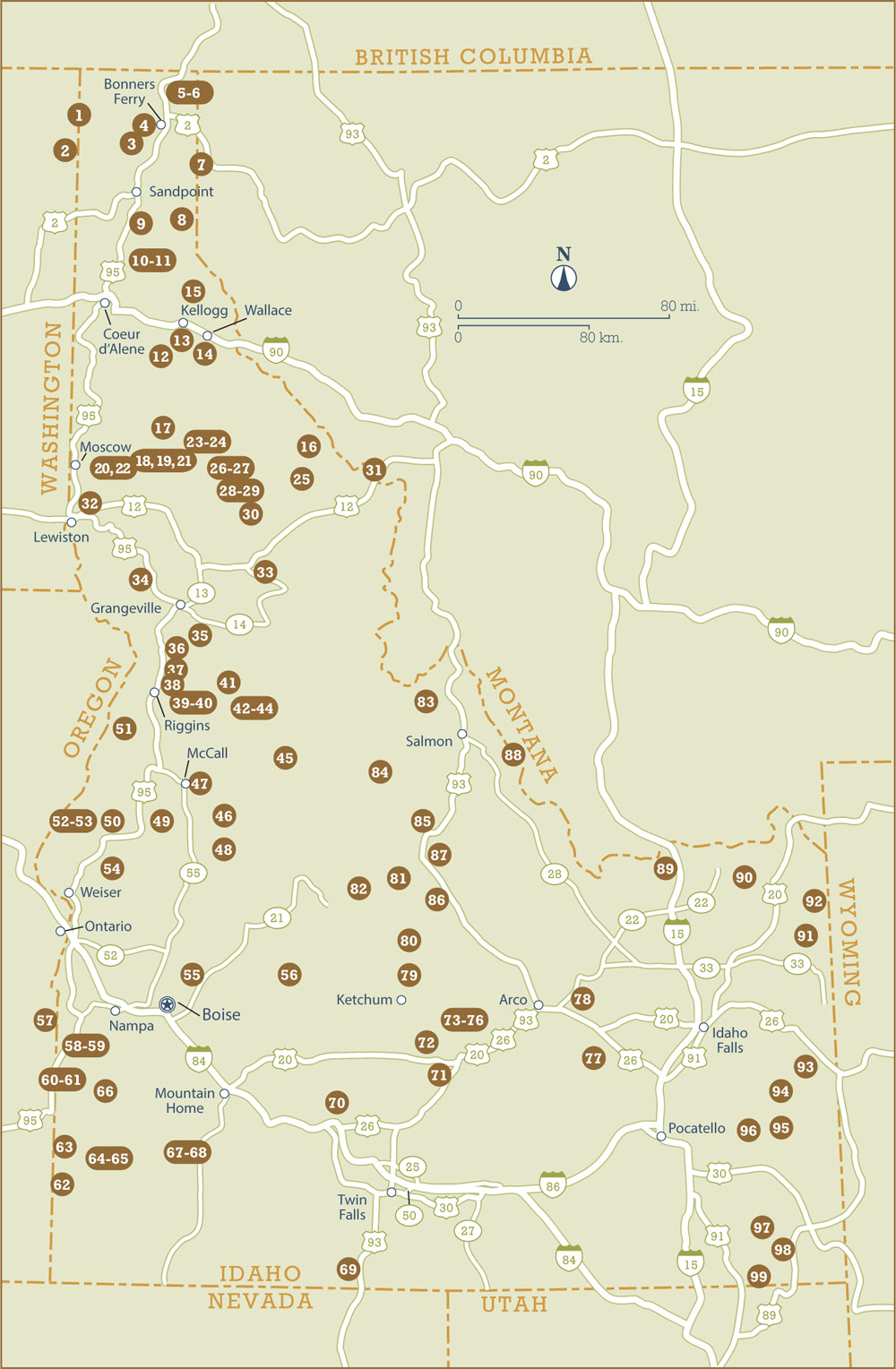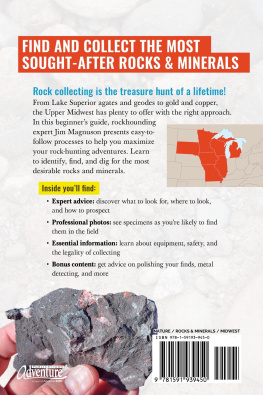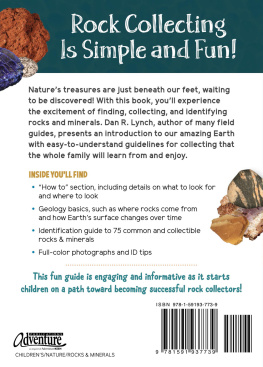

Garret Romaine has been an avid rockhound, fossil hunter, and gold prospector since the 1970s. He began his writing career as a journalist, covering sports, environment, business, and technology in the Portland, Oregon, area. He switched to technical writing and won numerous awards developing computer manuals. Garret teaches technical writing at Portland State University and was named a Fellow in the Society for Technical Communication. He holds a bachelors degree in geology from the University of Oregon and a masters degree in geography from the University of Washington, plus an MBA from Portland State University. His other titles for FalconGuides include Gold Panning the Pacific Northwest , Gold Panning California , Rocks, Gems, and Minerals of the Rocky Mountains , Modern Rockhounding and Prospecting Handbook , and Basic Rockhounding and Prospecting: A Beginners Guide . He also wrote Gem Trails of Oregon , Gem Trails of Washington , Gem Trails of Northern California , and Geology Lab for Kids . He is currently the executive director for the Rice Northwest Museum of Rocks and Minerals in Hillsboro, Oregon.


ROCKHOUNDING
Idaho
Help Us Keep This Guide Up to Date
Every effort has been made by the author and editors to make this guide as accurate and useful as possible. However, many things can change after a guide is publishedtrails are rerouted, regulations change, techniques evolve, facilities come under new management, and so forth.
We appreciate hearing from you concerning your experiences with this guide and how you feel it could be improved and kept up to date. While we may not be able to respond to all comments and suggestions, well take them to heart and well also make certain to share them with the author. Please send your comments and suggestions to the following address:
FalconGuides
Reader Response/Editorial Department
246 Goose Lane
Guilford, CT 06437
Thanks for your input, and happy rockhounding!
An imprint of The Rowman & Littlefield ublishing Group, Inc.
4501 Forbes Blvd., Ste. 200
Lanham, MD 20706
www.rowman.com
Falcon and FalconGuides are registered trademarks and Make Adventure Your Story is a trademark of The Rowman & Littlefield ublishing Group, Inc.
Distributed by NATIONAL BOOK NETWORK
Copyright 2010 The Rowman & Littlefield ublishing Group, Inc.
This FalconGuides edition 2020
Photos by Garret Romaine unless otherwise noted
Maps by The Rowman & Littlefield ublishing Group, Inc.
All rights reserved. No part of this book may be reproduced in any form or by any electronic or mechanical means, including information storage and retrieval systems, without written permission from the publisher, except by a reviewer who may quote passages in a review.
British Library Cataloguing-in-Publication Information Available
Library of Congress Cataloging-in-Publication Data available
ISBN 978-1-4930-3411-6 (paper: alk. paper)
ISBN 978-1-4930-3412-3 (electronic)
 The paper used in this publication meets the minimum requirements of American National Standard for Information SciencesPermanence of Paper for Printed Library Materials, ANSI/ NISO Z39.48-1992.
The paper used in this publication meets the minimum requirements of American National Standard for Information SciencesPermanence of Paper for Printed Library Materials, ANSI/ NISO Z39.48-1992.
The author and The Rowman & Littlefield Publishing Group, Inc., assume no liability for accidents happening to, or injuries sustained by, readers who engage in the activities described in this book.
CONTENTS
Guide
N obody should have to rockhound alone. It has been my pleasure to cover the state of Idaho with a dedicated team of helpers, who supported me with their skills at camping, hiking, cooking, navigating, and cooler care. In the hope of securing their attendance for future expeditions, I want to take the space to thank them by name: neighborhood friends Jake and Kyle Riley; trusted scout Dirk Williams; and my soapstone buddy, Marty Schippers. My family has been great, including my late father, Garret Lee; my late uncle Doug Romaine; my cousin John Romaine and his young son, Douglas; and, most importantly, my long-suffering wife, Cindy, who helps with the driving and occasionally lets me rockhound till dark.
Rachel Houghton provided an editing sanity check and helped with photography tools in the first edition. Tony Griffin, then president of the Idaho Gem Club, provided assistance in the early years and helped me track down a few wayward sites. Tim Fisher provided expert guidance as well. I thank you all.
Most of all, I want to acknowledge you, the reader. Thanks for helping to keep one of the oldest hobbies going, and thanks for whatever you end up passing down to the next generation. Ive met a lot of nice people while out rockhounding in Idaho; and I think you will too.
E very guidebook includes a lot of background information in the front and back. This one follows that template. If youre an experienced camper and longtime outdoors-type person, steeped in the ways of collecting but new to much of Idaho, you can skim through a lot of this introduction. If, in addition, you already have experience with Idaho rockhounding, you can skip even more and go right to the locales. I offer information, warnings, and guidelines here for safety compliance and as a way to welcome anyone new to the hobby.
Idahos Geology
The geological forces that shaped Idaho are complex and include at least five key events:
- The deposition and hardening of the great Belt Series, a large zone of Precambrian and Cambrian sediments occupying much of the Panhandle.
- The emplacement of the Idaho Batholith and related stocks such as the Kaniksu and Atlanta Batholiths. These granites intruded during the Mesozoic and make up the mountainous central region. They are very prominent.
- The birth of the Rocky Mountains added metamorphism and elevation, pushing up large blocks of older rock.
- A giant hot spot created the basalt plains, typified by Craters of the Moon, and is now beneath the Yellowstone Caldera. The basalt flows were accompanied by ash beds and lava tubes.
- Basin and range faulting, common throughout many of the western states, is spreading from the south.
Idaho is known as the Gem State thanks to those granite batholiths. As granite stocks push their way up through the older basement rocks, they melt or grind up rocks in their way. Pure granite is made up of silica and feldspars and other simple minerals, which freeze up first as the granite cools. Once all the normal material is locked up, there is often a remainder still circulating at the edges of the granite mass. This hot, quartz-rich solution can carry exotic material such as metals and sulfides. Idaho has witnessed many great gold rushes and stampedes into the mountains because the edges of the granite stocks are often shot through with big quartz veins. If cooling occurs at a slow, steady rate, even more interesting crystallization results, leading to pegmatite gems such as smoky quartz, topaz, sapphire, ruby, mica, beryl, and garnet. Simply put, you can never get tired of Idahos granite.
Next page







 The paper used in this publication meets the minimum requirements of American National Standard for Information SciencesPermanence of Paper for Printed Library Materials, ANSI/ NISO Z39.48-1992.
The paper used in this publication meets the minimum requirements of American National Standard for Information SciencesPermanence of Paper for Printed Library Materials, ANSI/ NISO Z39.48-1992.